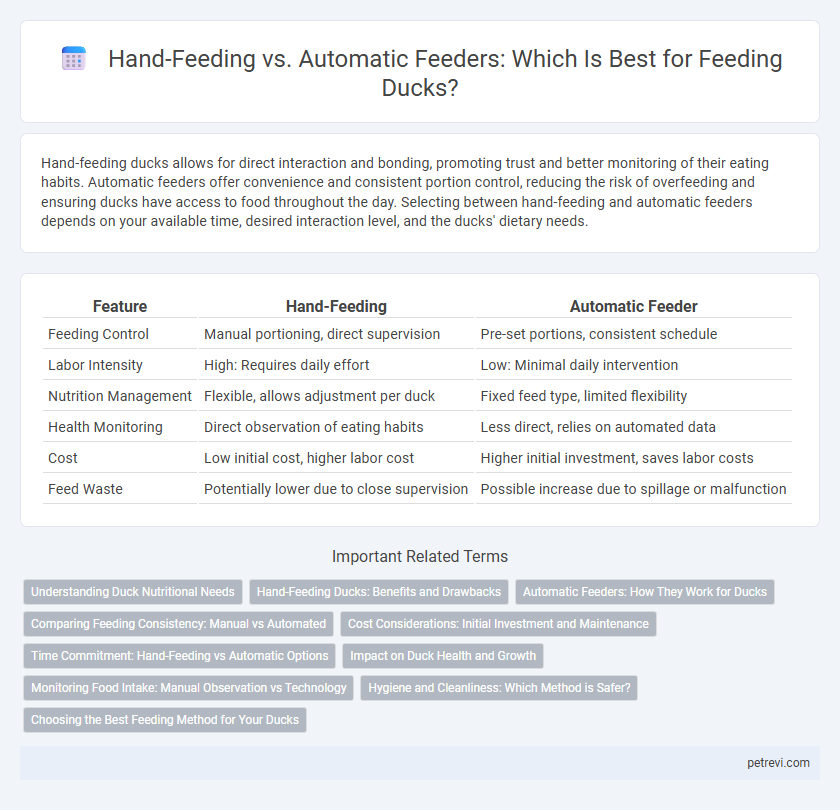Hand-feeding ducks allows for direct interaction and bonding, promoting trust and better monitoring of their eating habits. Automatic feeders offer convenience and consistent portion control, reducing the risk of overfeeding and ensuring ducks have access to food throughout the day. Selecting between hand-feeding and automatic feeders depends on your available time, desired interaction level, and the ducks' dietary needs.
Table of Comparison
| Feature | Hand-Feeding | Automatic Feeder |
|---|---|---|
| Feeding Control | Manual portioning, direct supervision | Pre-set portions, consistent schedule |
| Labor Intensity | High: Requires daily effort | Low: Minimal daily intervention |
| Nutrition Management | Flexible, allows adjustment per duck | Fixed feed type, limited flexibility |
| Health Monitoring | Direct observation of eating habits | Less direct, relies on automated data |
| Cost | Low initial cost, higher labor cost | Higher initial investment, saves labor costs |
| Feed Waste | Potentially lower due to close supervision | Possible increase due to spillage or malfunction |
Understanding Duck Nutritional Needs
Hand-feeding ducks allows for precise control over portion sizes and ensures a balanced diet tailored to their specific nutritional needs, including protein, vitamins, and minerals essential for growth and feather development. Automatic feeders provide consistent food availability but may lead to overfeeding or nutrient imbalances if not properly monitored. Understanding the dietary requirements of ducks, such as adequate calcium for eggshell strength and diverse plant-based nutrients, is crucial when choosing between hand-feeding and automated feeding systems.
Hand-Feeding Ducks: Benefits and Drawbacks
Hand-feeding ducks allows for direct interaction, promoting bonding and enabling better monitoring of individual health and dietary intake. This method provides precise control over portion sizes, reducing the risk of overfeeding and ensuring a balanced diet tailored to each duck's needs. However, hand-feeding can be time-consuming and may increase the risk of dependency or aggressive behavior if not managed properly.
Automatic Feeders: How They Work for Ducks
Automatic feeders for ducks operate by dispensing measured amounts of food at scheduled intervals, ensuring consistent nutrition and minimizing waste. These devices use programmable timers and sensors to regulate feeding times and portions, adapting to the ducks' daily dietary needs. By reducing human intervention, automatic feeders promote healthier growth, maintain feed hygiene, and optimize feeding efficiency in both domestic and commercial duck farming.
Comparing Feeding Consistency: Manual vs Automated
Hand-feeding ducks allows for personalized care and adjustment to each bird's eating habits, ensuring immediate response to feeding needs. Automated feeders provide consistent portion control and scheduled feeding times, reducing the risk of overfeeding or missed meals. Comparing feeding consistency, automated feeders offer reliable, precise nutrition delivery, while manual feeding depends on the caregiver's attention and timing accuracy.
Cost Considerations: Initial Investment and Maintenance
Hand-feeding ducks requires minimal initial investment, primarily involving purchasing appropriate feed and basic feeding tools, making it a cost-effective option for small-scale or hobbyists. Automatic feeders involve higher upfront costs due to the purchase of mechanical devices designed for efficient feeding but can reduce long-term labor expenses and feed waste through precise dispensing. Maintenance costs for automatic feeders include periodic cleaning, potential mechanical repairs, and electricity usage, whereas hand-feeding incurs negligible ongoing maintenance expenses.
Time Commitment: Hand-Feeding vs Automatic Options
Hand-feeding ducks requires consistent daily attention and time investment, ensuring personalized care and monitoring of each bird's health and eating habits. Automatic feeders reduce manual effort by delivering food on a preset schedule, freeing up time but potentially lacking the ability to detect feeding issues or individual needs. Choosing between hand-feeding and automatic feeding depends on balancing time availability with the importance of actively observing duck wellbeing.
Impact on Duck Health and Growth
Hand-feeding ducks allows for precise control of portion sizes and diet quality, which can promote optimal growth and prevent obesity or malnutrition. Automatic feeders provide consistent access to food, reducing stress and competition among ducks, but may lead to overeating and less dietary variation if not properly managed. Balancing these feeding methods supports healthy development by ensuring adequate nutrition while minimizing health risks.
Monitoring Food Intake: Manual Observation vs Technology
Hand-feeding ducks allows precise monitoring of individual food intake, ensuring each bird receives the proper nutrition and detecting any signs of illness through eating behavior. Automatic feeders provide consistent food supply but may lack detailed data on consumption patterns, potentially masking underfeeding or overfeeding issues. Combining manual observation with technology enhances overall feeding management by leveraging real-time data and personalized care.
Hygiene and Cleanliness: Which Method is Safer?
Hand-feeding ducks allows for close monitoring of food quality and quick removal of contaminated feed, reducing the risk of bacterial growth and illness. Automatic feeders, if not regularly cleaned and maintained, can harbor mold and bacteria due to moisture buildup, posing health risks. Proper hygiene protocols are critical for both methods, but hand-feeding offers more immediate control over feed cleanliness and duck health.
Choosing the Best Feeding Method for Your Ducks
Hand-feeding ducks allows for close monitoring of individual health and strengthens the bond between owner and bird, making it ideal for smaller flocks or young ducklings. Automatic feeders provide consistent, controlled portions and reduce labor, suitable for larger flocks or busy caretakers who need efficient feeding solutions. Selecting the best method depends on flock size, daily time availability, and the desired level of interaction, ensuring optimal nutrition and welfare for your ducks.
Hand-Feeding vs Automatic Feeder for Duck Feeding Infographic

 petrevi.com
petrevi.com